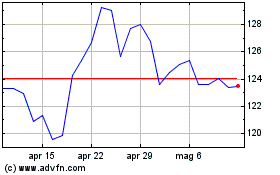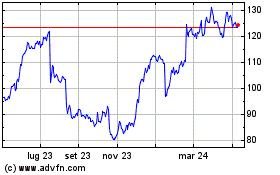Consumers Less Likely to Increase Spending in July According to Discover(R) Spending Confidence Monitor(sm)
18 Luglio 2007 - 2:00PM
Business Wire
The Discover� Spending Confidence Monitorsm revealed only 34
percent of consumers expected to spend more in July than they did
in June, a six point decline from last month�s inaugural survey.
While consumers sustained their spending from May to June, their
views on the economy remained pessimistic, as 62 percent rate the
economy as fair or poor and 59 percent expect the economy to
worsen. The survey by Discover� Card reveals the decline in
spending confidence coincides with an increased number of consumers
facing tighter budgets along with a decreased confidence in
personal finances. Thirty percent of consumers felt their personal
finances were improving compared to 34 percent last month.
Additionally, consumer confidence in managing their budgets
declined as fewer (49 percent) reported having money left over
after paying all of their bills compared to last month (55
percent). Consumers Less Likely to Increase Spending in July
Forty-nine percent of consumers said they expected to sustain their
spending from June to July, but when it comes to spending more,
fewer consumers expected to do so. Genders were fairly equal, with
only 33 percent of men and 35 percent of women planning to spend
more in July. Younger adults expected to spend more than older
adults with 42 percent of 18-29 year-olds saying they will spend
more in July. By contrast, less than a third (28 percent) of those
65 and older are planning to spend more, a nine point decline from
last month�s survey. �While consumers sustained their spending from
May to June, it appears that fewer are likely to increase July
spending,� said Margo Georgiadis, Executive Vice President and
Chief Marketing Officer for Discover Financial Services. �While
nearly half expect to spend about the same, there is a 15 percent
or 6 point drop from 40 percent to 34 percent of consumers
expecting to spend more from last month�s survey.� Increased
pressure on spending from added expenses or an income shortfall in
the next 30 days do not appear to be significant drivers of fewer
consumers expecting to spend more in July. A consistent 38 percent
of consumers expected these events in July and June. The number
expecting a shortfall in income or added expenses rises to 45
percent among adults under 40 and families with kids. Fewer Have
Money Left Over After Paying Bills, Nearly a Third Vulnerable if
Income is Suddenly Lost The number of consumers who had money left
over after paying monthly bills fell to 49 percent in June, down
from 55 percent in May. The drop was significantly worse among some
groups such as younger adults (18-29), where only 39 percent said
they had money left over compared to 48 percent in last month�s
survey. Families with kids saw a seven- point decline to 44
percent. A healthy 78 percent of those who did have money left over
expect to have the same or more money left over in July as well.
�How successful consumers are in meeting their budgets with money
left over is an important factor in spending confidence,� said
Georgiadis. �With a six-point decline from last month�s survey in
the number of people having money left over after paying their
monthly bills, there is a parallel drop in the number of consumers
expecting to spend more in July. Consumers are actively managing
their spending as budgets tighten.� Current numbers also showed 38
percent of consumers having no money left over after paying their
monthly bills, up from 34 percent from last month�s survey. The
number rises to nearly half (48 percent) among younger adults
(18-29). The number of families that had no money left over rose
from 38 percent in May to 46 percent in June. Beyond tighter
budgets, a rising number of consumers are at risk from a sudden
loss in income. The Discover survey examines how long consumers
could support their current lifestyle if they were faced with an
unexpected loss of income. Overall, 66 percent said they could
continue their current lifestyle for at least one month, but a
third (30 percent) said they would be unable to do so, up from 25
percent last month. Consumers Less Confident about Personal
Finances, Most Continue to Feel Economy is Getting Worse While last
month�s survey showed that consumers had a more optimistic view of
their personal finances than the economy, this month�s survey
revealed increased consumer pessimism about their personal finances
and the economy. A similar share of consumers continue to view
their personal finances as fair or poor (58 percent) versus good or
excellent (41 percent). However, the number of people who feel
their finances are improving dropped to 30 percent in June, down
from 34 percent in May. Forty-three percent feel their personal
finances are getting worse, the same number as last month.
Consumers� feelings about the economy were similar to June with a
consistent 62 percent rating the U.S. economy as fair or poor, and
35 percent rating it good or excellent. Less than a quarter (21
percent) feel the economy is improving, while 59 percent feel the
economy is getting worse. �Consumers� more robust view of their
personal finances versus the economy appeared to support their
expectation for sustained spending into June,� said Georgiadis.
�With consumer confidence in their personal finances declining as
well as concerns about the economy as a whole, consumers are more
cautious about their spending in July.� About the Discover Spending
Confidence Monitor The Discover Spending Confidence Monitor, being
released once a month, queried nearly 12,000 adult consumers in
June of 2007 on spending intentions and capacity. The survey also
asked for opinions on the U.S. economy and ratings of personal
finances. The survey was conducted by Rasmussen Reports, LLC, an
independent survey research firm (www.rasmussenreports.com). It has
a margin of error of +/- one percent. About Discover Financial
Services: Discover Financial Services (NYSE: DFS) operates the
Discover Card with more than 50 million cardmembers, the Discover
Network with millions of merchant and cash access locations, and
the Goldfish credit card business in the United Kingdom. Discover
Financial Services also operates the PULSE ATM/debit network, which
serves more than 4,400 financial institutions and includes nearly
260,000 ATMs, as well as POS terminals, nationwide. For more
information, visit www.discoverfinancial.com.
Grafico Azioni Discover Financial Servi... (NYSE:DFS)
Storico
Da Giu 2024 a Lug 2024

Grafico Azioni Discover Financial Servi... (NYSE:DFS)
Storico
Da Lug 2023 a Lug 2024
